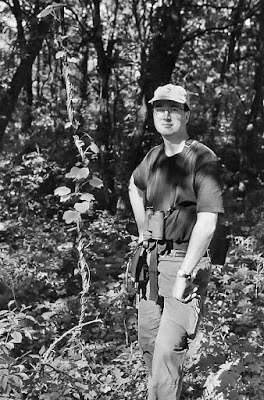As any sufficiently experienced birder would be able to do, I could submit a fictitious rare bird report to the Wisconsin Society of Ornithology or eBird and have it accepted based on its content accuracy, thoroughness, birder reputation, sans inclusion of a documentation photograph. Having submitted rare bird reports of actual birds and getting them accepted, I know the level of detail that's necessary to pass scrutiny and judgement by an ornithological records committee. Being familiar with avian topological terminology, all one needs to do is describe a bird in such terms along with a convincing observation narrative.
Would I ever do this? No ― of course not. Why not? Because, actually, I still somewhat care about the veracity of what gets entered into Wisconsin's records and citizen science projects like eBird. While caring, I no longer submit my own observations (except below) given concerns about the accuracy of the overall effort. Plus, it seems like an enormous waste of time and energy entering in list after list after list and staring at smartphones in the field. I mean, seriously, 500+ checklists entered in this year already by a single birder? Being generous to myself, maybe I've gone birding 50 times this year and I have over 200 species, too.
So, here's the thing about Dane County's most Reliable “Top eBirders” and other county lister lists: While some are actually very accomplished birders, this season I have witnessed several making rather obvious ID errors in the field, submitting mis-ID'd photographs, and others not knowing songs and calls of common birds like Northern Cardinal, American Goldfinch, and House Wren. There's under-reporting and over-reporting I've caught. And yet others ― whether intentionally or not ― are just plain pathological stringers: "If it was reported yesterday, who would be the wiser if I'm seen there by other birders and report it the following day?" What seems to matter more about such birders seems to be being at the top of a list and not so much the science aspect of their endeavors.
Thankfully, a savvy eBird reviewer can root out some errors by asking questions about a particular sighting, but given what I have observed this spring season on Dane County's eBird photographs, I wonder how many non-photograph entries are actually erroneous and get missed because they don't draw critical attention. If someone hears a Baltimore Oriole song and believes it to be a flycatcher, and enters it as such, why would a reviewer ever catch this? I suspect, when multiplied out by counties in a state, states in the country, there must literally be tens of thousands of mis-ID'd birds entered on eBird in the US per season.
The skillset of some new birders today is remarkably meager. To obtain high-count lists, one only needs:
- Access to numerous rare bird or “needs” alert platforms.
- Own transportation (car, bicycle, whatever).
- Read a map, follow directions.
- Ask another birder “Is it still here? Where is it?”
- Find the bird (be shown the bird), look at the bird.
- Enter it into the eBird app or jot it down in a notebook.
Anyone with this basic skillset can rank in a Top 20 state's county list. Does having this rank make one a good birder? Of course not, and in some cases this is readily obvious when you have them join your birding group … Birder Watching! Perhaps it's no wonder so many of them carry along telephoto rigs and super-zoom cameras. One look at the quality of photographs submitted with eBird reports it's quite obvious ― with few exceptions ― they're primarily documentation shots and not always accurately ID'd. Of course, if you're on a chase and someone points out the bird to you, being able to ID the bird yourself isn't even a priority.
Is there a solution? Maybe. Perhaps before one's data gets entered into the core eBird database they would be required to pass a comprehensive and broad taxonomical identification quiz with high threshold of 98%. I am sure someone behind the scenes at eBird would be able to provide what level of accuracy the overall database is acceptable and yet useful for ornithological science.
I am grateful that I spent a decade birding alone at Pheasant Branch before I became aware of the existence of our state's LISTSERV, the Wisconsin Birding Network. My birding interest began with cheap Nikon compact binoculars and a very sad Audubon field guide. Initially, I made a lot of mistakes ― but I caught them as I got better. As I refined my ID skillset based on GISS, song and vocalization themes, habitat and micro habitats, the diagnostic behavior and field mark process, phenology, etc., I eventually became the birding machine some of you know today. Rely less on the technology and more so on honing your raw ability.



